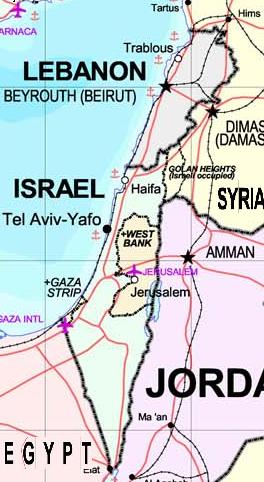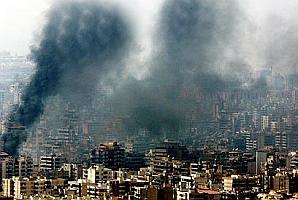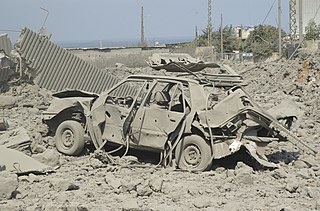
The Qana massacre took place on April 18, 1996, near Qana, a village in Southern Lebanon, when the Israel Defense Forces fired artillery shells at a United Nations compound. The artillery barrage had been launched to cover an Israeli special forces unit after it had come under mortar fire launched from the vicinity of the compound and radioed a request for support. Of 800 Lebanese civilians who had taken refuge in the compound, 106 were killed and around 116 injured. Four Fijian United Nations Interim Force in Lebanon soldiers were also seriously injured.

Operation Grapes of Wrath, known in Lebanon as the April Aggression, was a seventeen-day campaign of the Israeli Defense Forces against Hezbollah in 1996 which attempted to end rocket attacks on Northern Israel by the organisation. Israel conducted more than 1,100 air raids and extensive shelling. A UNIFIL compound at Qana was hit when Israeli artillery fired on Hezbollah forces operating nearby. 639 Hezbollah cross-border rocket attacks targeted northern Israel, particularly the town of Kiryat Shemona. Hezbollah forces also participated in numerous engagements with Israeli and South Lebanon Army forces. The conflict was de-escalated on 27 April by a ceasefire agreement banning attacks on civilians.
This is a timeline of events related to the 2006 Lebanon War.

The Israeli–Lebanese conflict, or the South Lebanon conflict, is a series of military clashes involving Israel, Lebanon and Syria, the Palestine Liberation Organization, as well as various militias and Militants acting from within Lebanon. The conflict peaked in the 1980s, during the Lebanese Civil War, and has abated since.

During the 2006 July War, a number of international incidents occurred in Lebanon, largely involving United Nations personnel who have come under a number of attacks by Israeli forces.

The 2006 Qana airstrike was an airstrike carried out by the Israeli Air Force (IAF) on a three-story building in the small community of al-Khuraybah near the South Lebanese village of Qana on July 30, 2006, during the 2006 Lebanon War. The strike killed 28 civilians, 16 of whom were children. Israel halted airstrikes for 48 hours following the attack, amid increasing calls for a ceasefire in the conflict between Israel and Lebanon's Hezbollah guerrillas.
There have been many casualties in the 2006 Lebanon War, leading to condemnation of both sides, however the exact distribution of casualties has been disputed. The Lebanese Higher Relief Council (HRC), UNICEF, and various press agencies and news organizations have stated that most of those killed were Lebanese civilians, however the Lebanese government does not differentiate between civilians and combatants in death toll figures. The Israeli government identified 43 Israeli civilians killed by Hezbollah rocket attacks, including four who died of heart attacks during rocket attacks. The Israel Defense Forces (IDF) death toll ranges from 118 to 121, depending on the source and whether or not casualties that occurred after the ceasefire are included. The figures for the Hezbollah fighters killed are the most varying, with Hezbollah claiming 250 of its fighters killed, while Israel claimed to have identified 530 dead Hezbollah fighters. The IDF estimates 600–700 dead Hezbollah fighters. Sources can be conflicting.

International reactions to the 2006 Qana airstrike, which saw the greatest loss of civilian life in the 2006 Israel-Lebanon conflict, twenty eight deaths with thirteen missing, largely involved the condemnation of Israel by many countries around the globe, bringing about a supposed 48 hours cessation of air operations by the Israeli Air Force. Bombings resumed only a few hours after the start of the cessation of air operations.

The 2006 Lebanon War, also called the 2006 Israel–Hezbollah War and known in Lebanon as the July War and in Israel as the Second Lebanon War, was a 34-day military conflict in Lebanon, northern Israel and the Golan Heights. The principal parties were Hezbollah paramilitary forces and the Israel Defense Forces (IDF). The conflict started on 12 July 2006, and continued until a United Nations-brokered ceasefire went into effect in the morning on 14 August 2006, though it formally ended on 8 September 2006 when Israel lifted its naval blockade of Lebanon. Due to unprecedented Iranian military support to Hezbollah before and during the war, some consider it the first round of the Iran–Israel proxy conflict, rather than a continuation of the Arab–Israeli conflict.

The Adnan Hajj photographs controversy involves digitally manipulated photographs taken by Adnan Hajj, a Lebanese freelance photographer based in the Middle East, who had worked for Reuters over a period of more than ten years. Hajj's photographs were presented as part of Reuters' news coverage of the 2006 Lebanon War, but Reuters has admitted that at least two were significantly altered before being published.
The Chyah Airstrike was an attack by the Israel Air Force (IAF) on the Shiyyah suburb in the Lebanese capital of Beirut on August 7, 2006, during the 2006 Lebanon War. Two missiles fired from an IDF bomber destroyed three apartment buildings in the suburb. Contemporary news accounts stated that the death toll from the airstrikes rose as recovery efforts continued, with 50 corpses recovered at the time of reportage and 61 anticipated.
The 2006 Ghaziyeh airstrikes also referred to as the 2006 Ghaziyeh massacre were two sequential attacks by the Israel Air Force (IAF) on the city of Ghaziyeh in Lebanon on August 7, and August 8, 2006. The attacks took place during the 2006 Lebanon War. In the first attack on August 7, the IAF bombed a building killing 16 people. In the second attack on August 8, the IAF fired five missiles into three buildings killing a total of 8 to 14 civilians and wounding 33. A total of 26 to 30 civilians died in the attacks.
Salam Daher is a Lebanese civil defense worker who was involved in the aftermath of the Israeli airstrike on Qana on July 30, 2006, where widely published photographs showed him removing dead children from the rubble of a house struck by an Israeli attack.

A number of incidents of attack on civilian and UN convoys have been reported. The Israel Defense Forces has disputed involvement in some cases, and has also alleged that no prior coordination took place before some affected convoys set out. These allegations have in turn been disputed. There have also been reports that fear of aerial attack has prevented drivers from transporting humanitarian aid within Lebanon. One estimate two weeks into the conflict placed the number of Lebanese truck drivers who had died as a result of IDF/IAF air strikes on convoys as "dozens".
This is a timeline of the 2006 Lebanon War during the month of July.
This is a timeline of the 2006 Lebanon War during early August.
During the 2006 Lebanon War, allegations of war crimes were made by various groups and individuals, including Amnesty International, Human Rights Watch, and United Nations officials, who accused both Hezbollah and Israel of violating international humanitarian law. These have included allegations of intentional attacks on civilian populations or infrastructure, disproportionate or indiscriminate attacks, the use of human shields, and the use of prohibited weapons.

Layal Najib, also Romanized Nagib, Nejib or Najeeb, was a Lebanese photojournalist for Agence France Press and Al Jaras and is the first journalist killed during the 2006 Lebanon War. She was also among several female journalists who were establishing their reputations as reporters during the war, such as Rima Maktabi and Najwa Qassem. Najib is one of seven journalists to have been killed since the end of civil war in 1990. Najib's death follows behind that of female journalist Atwar Bahjat who was killed while covering the Iraq War.

The Nabatieh Fawka attack occurred on 16 April 1996, when Israeli warplanes bombed an apartment in the village of Nabatieh Fawka, killing nine people, seven of whom were children.









